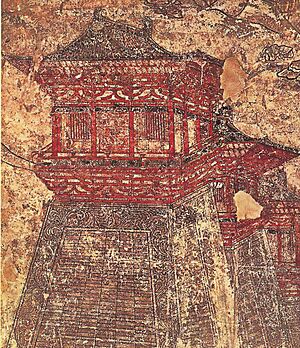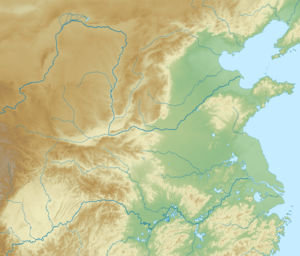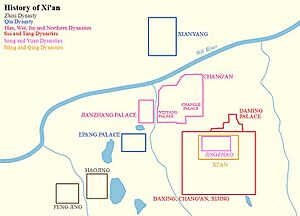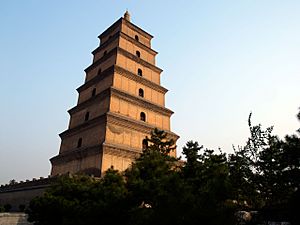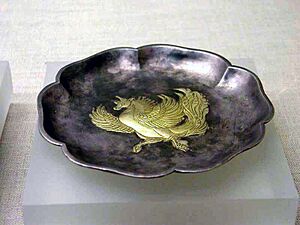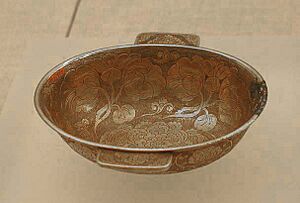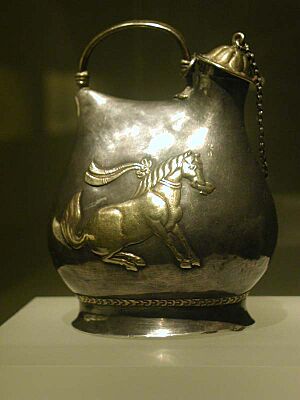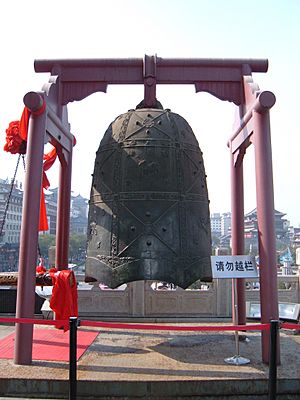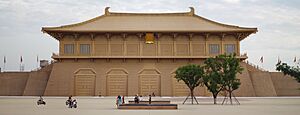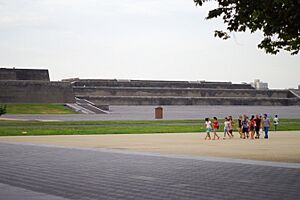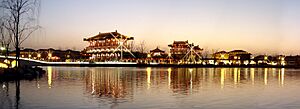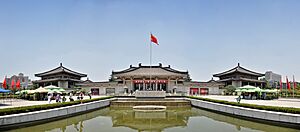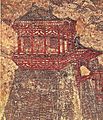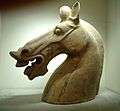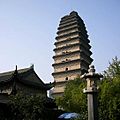Chang'an facts for kids
Quick facts for kids Chang'an |
|||||||||||||||||||||||||||||||
|---|---|---|---|---|---|---|---|---|---|---|---|---|---|---|---|---|---|---|---|---|---|---|---|---|---|---|---|---|---|---|---|
| Traditional Chinese | 長安 | ||||||||||||||||||||||||||||||
| Simplified Chinese | 长安 | ||||||||||||||||||||||||||||||
| Literal meaning | "Perpetual Peace" | ||||||||||||||||||||||||||||||
|
|||||||||||||||||||||||||||||||
Chang'an ([ʈʂʰǎŋ.án]; traditional Chinese: 長安; simplified Chinese: 长安; pinyin: Cháng'ān) is an old name for the city of Xi'an in China. For a long time, from 202 BCE to 907 CE, it was the capital city for many Chinese dynasties. People have lived in this area since ancient times, even during the Neolithic period. The Yangshao culture was found in Banpo, which is now part of Xi'an's suburbs.
Close to modern Xi'an, Qin Shi Huang, China's first emperor, had his court. He also built his huge tomb there, guarded by the famous Terracotta Army. The Qin dynasty ruled a larger area than earlier dynasties.
The imperial city of Chang'an during the Han dynasty was a bit northwest of today's Xi'an. During the Tang dynasty, Chang'an grew much larger. It was about eight times the size of the later Ming Xi'an. In its best days, Chang'an was one of the biggest and most populated cities in the world. Around 750 AD, Chinese records called it a "million-man city." Experts today think about 800,000 to 1,000,000 people lived inside its city walls.
Contents
Chang'an in the Han Dynasty
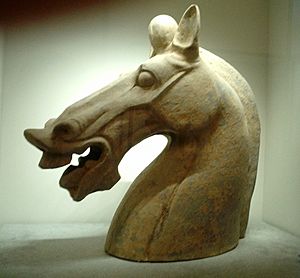
The Han capital city was located about 3 kilometers northwest of modern Xi'an. As the capital of the Western Han dynasty, it was the main center for politics, money, and culture in China. It was also the starting point in Asia for the famous Silk Road. This made it a very diverse city with people from many places.
Chang'an was a "consumer city." This means its large population was mostly there because it was the political and military heart of China, not mainly for making or trading goods. By 2 AD, about 246,200 people lived in 80,000 homes. Many of these people were scholars whose families paid for their education. There were also many workers who served them.
Why Chang'an was chosen
At first, Emperor Liu Bang wanted to build his capital near the Luo River, in what is now Luoyang. This spot was home to the holy city of Chengzhou, an old capital. However, the military importance of the Wei Valley made it the final choice for the new capital. Around 200 BC, Liu Bang moved thousands of military families to this area. This helped him keep an eye on possible rivals. It also helped him use their energy to defend the capital from the nearby Xiongnu people.
Building the City
Once the government was set up, the capital area was divided into three sections. Building began, and by 195 BC, Chang'an had 146,000 people. During the rule of Emperor Wu of Han, the diplomat Zhang Qian traveled west into Central Asia. After this, Chang'an became the main gateway between Asia and Europe, as the starting point of the Silk Road.
On October 4, 23 AD, Chang'an was attacked and damaged during a peasant rebellion. The emperor, Wang Mang, was killed two days later. After this, the Eastern Han government moved the capital to Luoyang. So, Chang'an was sometimes called the Western Capital or Xijing. In 190 AD, during the late Eastern Han period, the court was moved back to Chang'an by Prime Minister Dong Zhuo. This was because it was a better place to defend against growing rebellions. After Dong's death in 192, the capital moved back to Luoyang in 196. By then, Chang'an was seen as a very important symbol of power.
City Walls of Han Chang'an
The city wall was very long, about 25.7 kilometers. It was first 3.5 meters wide at the bottom and 8 meters tall, getting narrower to 2 meters wide at the top. Outside the wall, there was a moat (a ditch filled with water) that was 6.13 meters wide and 4.62 meters deep. Stone bridges, 13.86 meters long, crossed the moat. Later, the wall was made even bigger, 12 to 16 meters wide at the base and 12 meters high. The moat also became wider and deeper. This expansion likely helped protect the city from floods from the Wei River.
The wall had twelve gates, each with three openings, following old Chinese city planning rules. These gates were spread out, three on each side of the city. From these gates, eight main roads, 45 meters wide, stretched into the city. These roads also had three lanes, matching the three openings of the gates. Trees like pine and elm were planted in the middle of these lanes. Four of the gates led directly to the palaces.
How Han Chang'an was Built
The city was shaped like an uneven rectangle. Its shape was changed to look like the Big Dipper constellation for good luck. It also followed the curve of the Wei River. The eight main roads divided the city into nine areas. These nine areas were then split into 160 smaller, walled sections, each about 1 square li (an old Chinese measurement). About 50 to 100 families lived in each section.
Chang'an grew in four main steps:
- First step (200 to 195 BC): Palaces were built.
- Second step (195 to 180 BC): The outer city walls were built.
- Third step (141 to 87 BC): Many new palaces were added, with a peak around 100 BC.
- Fourth step (1 BC to 24 AD): The city was damaged during a rebellion.
The Xuanpingmen gate was the main gate between the city and its outer areas. The area north of the Weiyang Palace was the most exclusive. The main market, called the Nine Markets, was the eastern end of the Silk Road for trade. People mostly entered the market from the Northeast and Northwest gates. The Northeast gate connected to a bridge over the Wei River, leading to the northern suburbs. The Northwest gate connected to the rest of China to the east. There was also a secret network of underground tunnels connecting the imperial family's living areas with other palaces.
First Palaces
In 200 BC, Liu Bang asked Xiao He to design and build the new capital. He chose to build it on the ruins of an old Qin dynasty temple. This temple was believed to be a reflection of Polaris, the North Star, where the heavenly emperor lived. This made the site seem like the center of the earth. The ruins were made much larger, becoming the Changle Palace (长乐宫; 長樂宮; Chánglègōng). Two years later, a new palace called Weiyang Palace (未央宮; Wèiyānggōng) was built. Prime minister Xiao He told Liu Bang that having many large palaces was important to show his power and keep his rule strong.
Walls and Growth

In 195 BC, Liu Bang's son, Emperor Hui of Han, started building the walls of Chang'an. They were finished in September 191 BC. The city stayed mostly the same after this.
More Palaces and Parks
Emperor Wu started a third phase of building, adding many new palaces around 100 BC. He also built a complex of nine temples south of the city and created a large park. In 120 BC, Shanglin Park, which had been used by common people for farming, was made into an imperial park again. In the middle of the park, there was a recreation of three fairy islands in Kunming Lake.
Important Palaces
- Changle Palace (长乐宫; 長樂宮; Chánglègōng): Also called the East Palace. It was built on the ruins of an old Qin temple. After Liu Bang, it became the home of the Empress Regent. A 10,000-meter wall surrounded this large complex.
- Weiyang Palace (未央宮; Wèiyāng Gōng): Also known as the West Palace. This was the main government center from Emperor Huidi's time onward. It was a walled rectangle, 2250 by 2150 meters, with 40 halls inside. It had four gates, one for each main direction. The east gate was only for nobles, and the north gate was for common people. This palace was built on the highest part of the ridge where Chang'an stood. Its main hall was on the very highest point. This palace was used by seven dynasties and is very famous in Chinese history.
- Gui Palace (Chinese: 桂宫; pinyin: Guigōng): Built around 100 BC as an extension of the imperial family's living quarters.
- North Palace (Chinese: 北宮; pinyin: Běigōng): A ceremonial center built around 100 BC.
- Mingguang Palace (明光宫): Built around 100 BC as a guesthouse.
- Jianzhang Palace (建章宫): Built in 104 BC in Shanglin Park. It was a very large area with a tower 46 meters high. Its name means "palace of establishing eternal rules."
Later Dynasties and Changes
Chang'an was the capital for the Western Jin dynasty from 312 to 316. It also served as the capital for other kingdoms like Former Zhao (318–329), Former Qin (351–385), and Later Qin (384–417). In 417, the city was taken back by Liu Yu of Eastern Jin. However, it was lost to Northern Wei by 439. When Northern Wei split, Chang'an became the capital of Western Wei (535–557) and its successor, Northern Zhou (557–581).
Chang'an in the Sui and Tang Dynasties
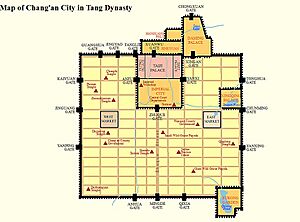
The Sui and Tang empires used the same location for their capital. In 582, Emperor Wen of the Sui dynasty chose a new area southeast of the old, ruined Han Chang'an to build his new capital. He called it Daxing (大興; 'Great prosperity'). Daxing was renamed Chang'an in 618 when Li Yuan became the first emperor of the Tang dynasty.
During the Tang dynasty (618–907), Chang'an was one of the biggest cities in the world, along with Constantinople and Baghdad. It was a global city with many people from other parts of Asia and beyond. This new Chang'an was built in a grid pattern, running north to south. It had 108 wards (city sections) and two large markets, one in the east and one in the west. Every day, market managers would beat gongs to signal the start and end of business. People in the wards were not allowed outside after curfew. Important officials lived closer to the main road.
Chang'an's design influenced how other Asian capitals were planned. For example, the Japanese built their ancient capitals, Heijō-kyō (today's Nara) and later Heian-kyō or Kyoto, based on Chang'an, though on a smaller scale. Modern Kyoto still has some features from Sui-Tang Chang'an. The Korean Silla dynasty also modeled their capital, Gyeongju, after Chang'an.
Chang'an was heavily damaged during rebellions, especially the An Lushan Rebellion. It was taken by rebels in 756 and then taken back by the Tang government in 757. It was briefly occupied by the Tibetan Empire in 763. In 779, laws were passed to separate foreigners from Han Chinese. For example, Uighurs in Chang'an had to wear their traditional clothes and were not allowed to marry Chinese women.
The city was attacked and occupied by rebels several more times. In 881, Huang Chao took Chang'an. In 904, Zhu Quanzhong ordered the city's buildings to be torn down. The materials were moved to Luoyang, which became the new capital. The residents, including the emperor, were also forced to move. Chang'an never fully recovered after the Tang dynasty's peak. However, some monuments from the Tang era still stand today.
After Zhu Quanzhong moved the capital, a smaller city was rebuilt on the site of the old Imperial City. This "new city" was much smaller, less than 1/16 the size of the old Chang'an. Its name was later changed to Xi'an in the Ming dynasty.
City Layout in the Tang Dynasty
During the Tang dynasty, Chang'an's main outer walls were about 18 feet (5.5 meters) high. The city was a rectangle, about 5 miles (8 km) by 6 miles (9.6 km) long, covering an area of 30 square miles (77.7 sq km). Areas like the West Park, East Park, and Daming Palace extended out from the main wall. The Serpentine River Park was also walled off in the southeast. Outside the city to the northwest was a Forbidden Park with orchards and fields for sports like horse polo and cuju (ancient Chinese football).
The city had many streets, but there were also major roads that were much wider. These main roads were lined up with the city's nine gates. The narrowest streets were 82 feet (25 meters) wide. Roads leading to the outer gates were 328 feet (100 meters) wide. The widest road, the Imperial Way, stretched from the central southern gate to the West Palace in the north and was 492 feet (150 meters) wide. These wide streets helped stop fires from spreading. For example, in 843, a large fire destroyed 4,000 buildings in the East Market, but the wide streets kept the rest of the city safe. In 740, fruit trees were planted along all the city's main roads, which made citizens happy.
Waterways in Tang Chang'an
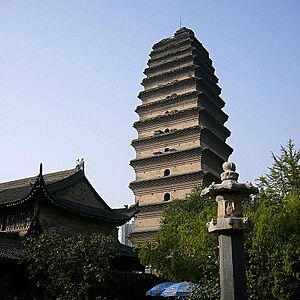
The West Park had a running stream, and the West Palace had two streams connecting several ponds. The small East Park also had a pond. The Daming Palace and the Xingqing Palace had small lakes. The Serpentine River Park had a large lake, fed by a river that ran under the main city walls.
Five canals ran through the city, bringing water to parks, rich people's gardens, and imperial palaces. This water came from streams outside the city and from the East Park's pond. These canals also helped transport important goods like charcoal and firewood in winter.
Life and Places in Tang Chang'an
South Central Chang'an
This area had 20 walled sections. It was home to Buddhist monasteries, Taoist temples, and family shrines. In 815, a high-ranking official named Chancellor Wu was killed as he left a ward in this area. An imperial prince was once criticized for building something that blocked a street here. The famous rebel An Lushan had a garden in this sector. There was also a garden where students who passed the important Advanced Scholar's Exam could hold parties. One ward was once a place to sell animals and slaves, but it became a training ground for archers. There was also a special garden that grew food for the imperial prince's family.
Southeastern Chang'an
This sector had 13 walled sections, with Buddhist monasteries, Taoist temples, and family shrines. The Serpentine River Park was in this area, containing a monastery and a family shrine. A garden for the heir apparent (the next in line for the throne) was located here. A pastry shop stood near a northern gate, close to an ancient shrine where people visited on special days. One ward had half its area as a graveyard. This sector was also home to a large monastery with the Giant Wild Goose Pagoda (built in 652), which is still standing today at 64 meters tall. Students would visit this monastery to write their names after passing exams. This ward also had a large bathhouse and an entertainment area.
West Central Chang'an
This area had 11 walled sections, including a large marketplace. The West Market was huge, covering two city wards. It had a Persian bazaar with goods and styles popular in medieval Iran. There were many shops selling wine, tea, pastries, and cooked foods. A safety deposit firm was also located here. Government offices in the market monitored trade. This sector also housed the offices for Chang'an County, the western half of the city. The main office of Chang'an City's mayor was here, along with the mansion of a Turkic prince. In 613, a family threw their gold into a well because they feared the government would take it. The West Market (and East Market) opened at noon, announced by 300 drum beats, and closed before dusk, signaled by 300 gong beats. Small night markets would open in residential areas after the main markets closed.
Central Chang'an
This sector had 16 walled sections, with many Buddhist monasteries, Taoist temples, and official temples. It also had provincial offices and inns. There was a court for imperial musicians. A minister's mansion here had a "pavilion of automatic rain," which was an early form of air conditioning using a rotary fan. Once, a scholar was hit on the head by a football, and the emperor gave him ale out of kindness. In 720, parts of a ward's walls collapsed during a storm. The mansion of Princess Taiping (died 713) was in this area. The main Capital Schools, including the Sons of State Academy, were located here. Other colleges for law, mathematics, and calligraphy were also present. One ward had the most entertainment areas in the city. The Small Wild Goose Pagoda, which still stands, is in this sector. A government-run mint for making copper coins was also here.
East Central Chang'an
This sector had 11 walled sections, with Buddhist monasteries, Taoist temples, and even a foreign place of worship. The East Market was here, similar to the West Market, with nine city blocks and government offices to regulate trade. There was a street called "Ironmongers' Lane" and shops selling foreign musical instruments. The offices of Wannian County, the eastern half of the city, were in this area. The main office of the Municipal Archives and the government's Directorate for Astronomy were also located here. In 775, a Uyghur man stabbed someone in the East Market. His chieftain later broke him out of prison. A princess had a mansion here with a large polo field. Emperor Gaozong of Tang (ruled 649–683) once held his daughter Princess Taiping's wedding feast here. A mansion given to the rebel An Lushan in 750 was later turned into a Buddhist temple after his death. A high-ranking general's mansion in the mid-8th century was said to have 3,000 family members living in it. There was also a Zoroastrian Fire-Temple.
Northwestern Chang'an
This sector had 12 walled sections, with many Buddhist monasteries, Taoist temples, and six foreign places of worship, including three Zoroastrian Fire-Temples and three Persian Nestorian-Christian churches. The military barracks for the Divine Strategy Army were located here. There was a shrine for Laozi's father. The office of the Inexhaustible Treasury was also here. In 828, a dispute over land led to a large gathering of people in the streets. The home of An Jinzang, who bravely defended Emperor Ruizong of Tang, was in this area. In 713, Emperor Xuanzong closed down the very rich Inexhaustible Treasury, which was run by a Buddhist monastery. He said their banking was not fair, took their wealth, and gave it to other monasteries and for city repairs.
North Central Chang'an
This sector included large walled areas connected to the West Palace and the main city walls. It had 24 walled sections and 14 different armed guard units. The August Enceintes, a large walled compound of 24 wards, was the Administrative City. This is where the central government offices were located, in front of the West Palace. The headquarters for the Service for Supreme Justice (like a Supreme court) were here. Imperial factories and stables for horses were also in this area. Government halls for civil and military exams and the Imperial ancestral shrine were also located here. In 713, a large carnival was held along the main road near the West Palace.
Northeastern Chang'an
This sector had 14 walled sections, with many Buddhist monasteries, Taoist temples, and provincial offices. The Xingqing Palace, once a Buddhist monastery, became an Imperial palace in the early 8th century. It had a large lake, streams, and an archery hall. A large carriage park allowed officials to leave their horse-drawn vehicles when visiting the Daming Palace. One entertainment ward in this sector was known for having the best singers, and another for the best dancers. Empress Wu once gave one of her dressing rooms to a monastery here. In 730, Emperor Xuanzong of Tang had four palace halls taken apart and rebuilt as halls and gates for a Taoist temple. In 835, palace troops captured rebel leaders in a tea shop who were planning a rebellion. A mansion of Princess Tongchang had a water well lined with pure gold and silver. There was a large playing ground for horse polo. In 756, the rebel An Lushan ordered many princesses and their families to be killed in this area. A street here was where the emperor would organize public shows to celebrate his birthday.
West Palace
The West Palace grounds included:
- An archery hall
- Polo grounds
- Beautiful gardens
- Five large ponds and three streams
- A cuju football field
- A drum tower
- A bell tower
- The home of the Crown Prince, called the 'East Palace'
- The Flank Court, where women were held if their husbands or male family members committed crimes.
- The school for palace ladies
- The office of the Eunuch Agency
West Park
The West Park grounds included:
- A river stream
- Three gates leading into the West Palace
- Ice pits for keeping foods cold during spring and summer
Daming Palace
The Daming Palace grounds included:
- Double walled gates at the north end leading out of the city, and one walled gate at the south end leading into the city
- A large lake
- An archery hall
- A bathhouse
- A storehouse for musical instruments
- A drum tower
- A bell tower
- A cuju football field
- A cockfighting arena
- An Academy of music for actors and performers
- A separate entertainment ward
East Park
The East Park grounds included:
- A large pond
- Two streams (one leading into the park, one feeding a city canal)
- A cuju (traditional Chinese soccer) field
Citywide Events and Festivals
Chang'an celebrated many traditional Chinese holidays with grand festivals:
- New Year: This was the biggest festival, a seven-day holiday for government officials. Officials and foreign visitors gathered to review the past year and present gifts. It was also a time for governors to suggest candidates for the imperial examination. While city ceremonies were grand, people in the countryside celebrated at home with family traditions, like drinking a special wine believed to cure illnesses.
- Lantern Festival: A three-day festival held on the 14th, 15th, and 16th days of the first full moon. This was the only time the government lifted the nightly curfew, allowing people to walk freely on the main streets. Citizens competed to put up the most and largest lamps. In 713, the recently retired Emperor Ruizong of Tang set up a huge lantern wheel, 200 feet (61 meters) tall, decorated with silk and jewels. When its 50,000 oil lamps were lit, its glow could be seen for miles.
- Lustration: This one-day festival took place on the third day of the third moon. Traditionally, it was meant to wash away bad luck in a river. By the Tang era, it became a time for celebration, feasting, and writing poetry. The Tang court served special deep fried pastries for the occasion, often in the Serpentine River Park.
- Cold Food Festival: This holiday on April 5 (same as the Qingming Festival) was named because no fires were allowed for three days, meaning no hot food. It was a time to honor ancestors by caring for their tombs and offering sacrifices. Later, people would have a picnic. It was also a fun time for outdoor activities like swing sets, cuju football, horse polo, and tug of war. In 710, Emperor Zhongzong of Tang watched his officials play tug of war and laughed when the oldest ones fell over. The emperor also gave porridge and dyed chicken and duck eggs to officials, similar to Easter traditions.
- Fifth Day of the Fifth Moon (Dragon Boat Festival): This holiday honored an ancient Chinese statesman, Qu Yuan (around 340-278 BC). He was so sad he couldn't help his state that he jumped into a river. People then went out in boats to try and rescue him. This act became a tradition of dragon boat races. People commonly ate glutinous millet or rice wrapped in leaves and boiled for this festival.
- Seventh Night of the Seventh Moon: This festival celebrated the celestial love story of the cow-herd deity (star Altair) and the weaver maid deity (star Vega). Women prayed to improve their sewing and weaving skills. In the early 8th century, a 100-foot (30-meter) tall hall was built for offerings to the two star lovers.
- Fifteenth Day of the Seventh Moon (All Saints' Feast): This holiday came from the legend of Mulian Rescues His Mother. Mulian, a Buddhist holy man, found his mother suffering in a place for hungry ghosts. She couldn't eat because food turned to charcoal. She told Buddha to make an offering on the 15th day of the seventh month to free people from being hungry ghosts. After Mulian saved his mother, the day became a permanent holiday. Buddhist monasteries used this day to show off their wealth and attract donations with dramatic shows.
- Fifteenth Day of the Eighth Moon (Mid-Autumn Festival): This festival took place in mid-autumn and was a three-day vacation for government officials. It was linked to Taoism and the tale of a hare on the moon grinding ingredients for an elixir of life. People in Chang'an would feast and drink for the night.
- Ninth Day of the Ninth Moon: This was a three-day holiday about living a long life, with chrysanthemum as its symbol. Many people would have picnics in the countryside, especially on mountains. Those in Chang'an would feast on top of pagodas or in the Serpentine River Park. Chrysanthemum stems and leaves were brewed into an ale that was believed to prolong life.
- The Last Day of the Twelfth Moon: On this holiday, ale and fruit were offered to the god of the stove. Buddhist or Taoist priests would read scriptures at homes. Offerings were made to the stove god because he reported to heaven about the family's good or bad deeds. Families would try to charm the god, even rubbing alcohol on his picture so he wouldn't make bad reports.
- Grand Carnivals: carnivals during the Tang period were lively events with lots of eating, drinking, street parades, and sideshows. They didn't have fixed dates but were celebrations given by the emperor for special reasons, like military victories, good harvests, or granting amnesties. These carnivals usually lasted 3, 5, 7, or 9 days. They were often held on the wide avenues of the city. Tang dynasty carnivals featured large wagons with high poles for acrobats and huge floats, sometimes five stories high, called 'mountain carts'. These floats were decorated with silk and drawn by oxen dressed to look like other animals.
- In 682, a series of droughts, floods, locust plagues, and epidemics led to a widespread famine in Chang'an and Luoyang. Food prices became very high, ending a prosperous time.
Decline of Chang'an
The once thriving Tang capital quickly declined after the end of the Tang dynasty. In 880, the rebel Huang Chao attacked the city, destroying much of it. When the warlord Zhu Wen attacked again 25 years later, the capital was moved from Chang'an to Luoyang. Much of Chang'an was then abandoned and fell into disrepair. Over time, nature took over many parts of the city, and some areas were used for farming.
The former imperial city was rebuilt into a much smaller city. Its northern and eastern walls were slightly expanded. The official name of the city was changed from Jingzhao (which meant "capital city") to Xi'an in the Ming dynasty.
Images for kids
-
A terracotta horse head from the Han dynasty
-
Qing-era map of Weiyang and Chang'an Palace
-
Map of Chang'an during the Tang dynasty
-
The Giant Wild Goose Pagoda, built in 652 AD, located in the southeast sector of Chang'an.
-
The Small Wild Goose Pagoda, built in 709 AD, damaged by an earthquake in 1556 but still standing, in the central sector of Chang'an.
See also
 In Spanish: Chang'an para niños
In Spanish: Chang'an para niños


